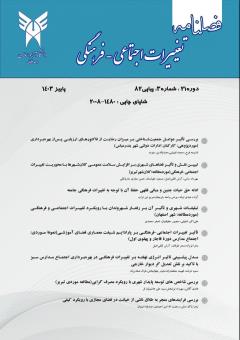تبیین نقش و تأثیر فضاهای شهری بر افزایش سلامت عمومی کلانشهرها با محوریت تغییرات اجتماعی-فرهنگی (موردمطالعه: کلانشهر تبریز)
محورهای موضوعی : تحولات اجتماعی
مهرداد سامی
1
,
آرش ثقفیاصل
2
,
مسعود حقلسان
3
![]() ,
حسن ستاری ساربانقلی
4
,
حسن ستاری ساربانقلی
4
1 - دانشجوی دکتری شهرسازی، واحد تبریز، دانشگاه آزاداسلامی، تبریز، ایران.
2 - دانشیار گروه معماری و شهرسازی، واحد تبریز، دانشگاه آزاداسلامی، تبریز، ایران.
3 - استادیار گروه معماری و شهرسازی، واحد ایلخچی، دانشگاه آزاد اسلامی، ایلخچی، ایران.
4 - دانشیار گروه معماری و شهرسازی، واحد تبریز، دانشگاه آزاد اسلامی، تبریز، ایران.
کلید واژه:
چکیده مقاله :
فضاهای شهری بهعنوان محیطهایی که بیشترین وقت افراد در آنها سپری میشود؛ پلی بین جنبۀ اجتماعی و فرهنگی و زیستی زندگی انسانها بوده و تأثیر بسیار عمیقی بر سلامت جسمانی و روانی دارند. هدف تحقیق حاضر بررسی نقش و تأثیر فضاهای شهری بر افزایش سلامت عمومی در کلانشهر تبریز با محوریت تغییرات اجتماعی-فرهنگی است. روشتحقیق در مطالعۀ حاضر کمی با هدف کاربردی و ماهیت تحلیلی-اکتشافی میباشد که درراستای تجزیهوتحلیل اطلاعات از تحلیل واریانس و ضریب رگرسیون در نرمافزار “Spss”، استفاده شده است. همچنین جامعۀ آماری تحقیق شامل شهروندان تبریزی بوده که حجم نمونه براساس روش کوکران 384نفر تعیین گردیده و دسترسی بهآنها برمبنای الگوی تصادفی ساده بوده است. قلمرو جغرافیایی پژوهش حاضر شامل فضاهای منتخب در اجتماع کلانشهر تبریز بهمثابۀ؛ بازار بزرگ تبریز، پارک ائلگلی، مجتمع تجاری لالهپارک، پیادهراه تربیت، خیابان 29بهمن، فلکۀ بزرگ و دانشگاه آزاداسلامی میباشد. یافتههای تحقیق نشان میدهد که سطح سلامت جسمی افراد در مجتمع لالهپارک بیشاز سایر فضاها و در دانشگاه آزاداسلامی کمتر از سایر فضاهای موردبررسی ابراز شده است. تغییرات اجتماعی-فرهنگی باعثگردیده سطح سلامتروان نیز در پیادهراه تربیت بیشاز سایر فضاهای موردبررسی ابراز شده است. درنتیجه، سلامت عمومی شهروندان در پیادهراه تربیت و مجتمع لالهپارک با میانگین 48/3 و 46/3 بیشاز سایر فضاها گزارش شده است. نشان میدهد که بالابودن سطح کیفیت مفاهیم تبیینکنندۀ سلامت جسمی و روانی منجربه افزایش کیفیت سلامت عمومی شهروندان در فضاهای شهری شده و بایستی مبنای مطالعات اجتماعی و فرهنگی در اجتماع عمل طراحان و برنامهریزان شهری قرار گیرد.
Urban spaces, as environments where people spend most of their time, serve as a bridge between the social, cultural, and biological aspects of human life and have a profound impact on both physical and mental health. The aim of the present research is to examine the role and impact of urban spaces on improving public health in the Tabriz metropolis, with a focus on socio-cultural changes. The research method used is quantitative, with an applied purpose and an analytical-exploratory nature. In order to analyze the data, analysis of variance and regression coefficients were employed using “SPSS”, software. The statistical population of the research consists of Tabriz citizens, and the sample size was determined as 384 people based on Cochran's formula, with a simple random sampling method used for data collection. The geographical scope of the study includes selected urban spaces in the Tabriz metropolis, such as the Tabriz Grand Bazaar, El-Goli Park, Laleh Park Commercial Complex, Tarbiat Pedestrian Street, 29th Bahman Street, Felake Bozorg, and Islamic Azad University. The findings indicate that the level of physical health was reported highest in the Laleh Park Commercial Complex and lowest at Islamic Azad University among the studied spaces. Socio-cultural changes have also resulted in a higher level of mental health being reported in Tarbiat Pedestrian Street compared to the other examined spaces. Consequently, the overall public health of citizens was reported highest in Tarbiat Pedestrian Street and Laleh Park Complex, with average scores of 3.48 and 3.46, respectively, surpassing other spaces. These results demonstrate that higher quality in the factors defining physical and mental health leads to an improvement in the overall public health of citizens in urban spaces, and this should serve as a foundation for urban designers and planners in their social and cultural studies and interventions.


